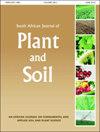Optimising the rate and stages of application of nitrogen fertiliser for stevia under greenhouse conditions
IF 0.7
Q3 AGRONOMY
引用次数: 0
Abstract
Nitrogen (N) is the nutrient most used by crop producers and its application may affect the N use efficiency in crop production. The present study was conducted in order to determine the optimum N fertiliser rate and application stages (S) for stevia (Stevia rebaudiana Bertoni) production for the first cutting, under greenhouse conditions. A two-factorial experiment with four N fertiliser rates (0, 40, 80 and 120 kg ha−1 applied as urea) and three stages (sole split N applied at sowing; dual split N applied at sowing and one month after sowing; triple split N applied at sowing, one and two months from sowing) were laid out in a completely randomised design. Each treatment combination was replicated three times. The plants were grown in boxes (1 m−2, 40 cm high) filled with loam soil and the treatments were applied as described. Results showed that stevia growth and metabolites were significantly affected by N rates and application stages. Stevia leaf area index (LAI), leaf yield, leaf/stem ratio and harvest index (HI), steviol glycosides (SVglys) content, SVglys compositions and yield were the highest when 40 kg N ha−1 was applied in two stages. This was also true for leaf and SVglys yield. Splitting of N application of 120 kg ha−1 into three stages showed an inhibitory effect on some stevia traits such as SVglys content and yield. Based on the current results and efficient N application, 40 kg N ha−1 split into two stages is recommended for stevia production under greenhouse conditions.在温室条件下优化甜菊的氮肥施用速率和阶段
氮是作物生产者使用最多的营养素,其施用可能会影响作物生产中的氮利用效率。本研究旨在确定在温室条件下,甜菊(甜叶菊)第一次扦插生产的最佳氮肥用量和施用阶段(S)。四种氮肥用量(0、40、80和120)的两因子试验 kg ha−1作为尿素施用)和三个阶段(播种时施用单裂氮;播种时和播种后一个月施用双裂氮;在播种时施用三裂氮,播种后一和两个月)以完全随机的设计进行布置。每个治疗组合重复三次。这些植物生长在盒子里(1 m−2,40 cm高),并按所述进行处理。结果表明,施氮量和施用阶段对甜菊的生长和代谢产物有显著影响。甜菊叶面积指数(LAI)、叶产量、叶茎比和收获指数(HI)、甜菊糖苷(SVglys)含量、SVglys成分和产量在40 kg N ha−1分两个阶段施用。叶片和SVglys产量也是如此。120的N应用程序的拆分 kg ha−1分为三个阶段对甜菊糖含量和产量等一些性状表现出抑制作用。根据目前的结果和有效的N应用,40 建议将kg N ha−1分为两个阶段用于温室条件下的甜菊生产。
本文章由计算机程序翻译,如有差异,请以英文原文为准。
求助全文
约1分钟内获得全文
求助全文
来源期刊

South African Journal of Plant and Soil
Agricultural and Biological Sciences-Plant Science
CiteScore
1.90
自引率
11.10%
发文量
32
期刊介绍:
The Journal has a proud history of publishing quality papers in the fields of applied plant and soil sciences and has, since its inception, recorded a vast body of scientific information with particular reference to South Africa.
 求助内容:
求助内容: 应助结果提醒方式:
应助结果提醒方式:


